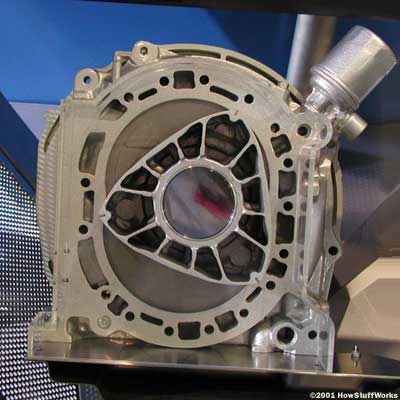An air-cooled engine block is very simple to produce but does not cool efficiently enough to keep up with modern performance demands. This is why the typical automotive cooling system today uses a water cooled system, containing a car radiator, engine coolant and a water pump which pressurizes the hot liquid through a series of radiator hoses and tubes.
The radiator in a car works on the exact same heat transfer principles as a simple heat sink; the radiator contains hundreds of those fins.
The radiator inlet tank receives hot liquid from the engine block, which passes through these fins where cooling fans force air between them. As a result, the radiator cools hot liquid and returns it to proper operating temperature before sending it back to the engine.
Regulating Hot Coolant
The engine's cooling system is under constant stress to achieve proper cooling and eliminate excess heat while the engine is running. High coolant temperature — or worse, low coolant level — can be immediately catastrophic for an engine block. Such an engine requires a robust and maintained water cooling system to control temperature.
In order to perform their best, cooling systems need all of their components — the car radiator, hoses, tubes, the water pump and reservoir tank — to be regularly inspected and replaced if necessary. One bad seal or small crack in the engine's cooling system can prevent coolant flowing properly, building up excess heat and eventually causing big problems for your engine.
The Water Pump
Second only to the car radiator, the water pump is one of the most important cooling components in an engine (and a likely failure point). It is driven by the timing system, pressurizing engine coolant and keeping it flowing through the entire system at a regulated pace.
As the water pump is always running alongside the engine, it is prone to wear and will eventually malfunction. A worn-out pump can obstruct coolant from flowing properly through the radiator, and it can also begin to leak coolant itself.
The water pump should always be inspected during regular vehicle maintenance and replaced at the first sign of potential failure.
The Radiator Cap
When coolant fluid overheats, it expands, causing the fluid to become highly pressurized. When it enters the radiator, the pressure of circulating liquid increases even more because it’s in an enclosed space.
The radiator cap (or pressure cap) acts as a release valve set to open at the maximum pressure point. Usually this is set at a density of 15 pounds per square inch (psi).
When the fluid pressure inside the radiator exceeds 15 psi, it forces the valve open, allowing heat to escape and excess coolant fluid to overflow into the tanks on either side of the radiator. Once the radiator cools down, the coolant fluid in the overflow tanks gets sucked back into the pump, continuing its route through the cooling system.
Secondary Cooling System
Cars with automatic transmissions also require transmission cooling in the same way, with a separate heat-exchange circuit built into the car radiator. This two-step process of cooling the transmission fluid is equivalent to a radiator within a radiator.
As the heated transmission fluid enters the transmission cooler, the oil’s heat is exchanged with the coolant fluid in the car radiator, making the transmission fluid cooler while heating the coolant fluid instead. Then the coolant fluid’s heat is transferred to air in the radiator itself.
In addition to the main cooling system on the engine, cars also typically contain an air conditioner cooling system which uses a smaller radiator and a liquid refrigerant to regulate temperature inside the vehicle's cabin.



